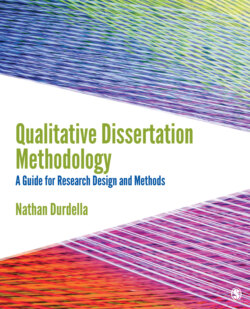Читать книгу Qualitative Dissertation Methodology - Nathan Durdella - Страница 78
На сайте Литреса книга снята с продажи.
Guiding principles of qualitative dissertation methodology.
ОглавлениеThe traditional approaches to inquiry associated with qualitative research—ethnography, phenomenology, grounded theory, for example—generally direct the design and methods in dissertation methodologies. As such, the assumptions about human social life and principles that guide methodological decisions tend to circumscribe what researchers propose to do in their studies. However, even the strictest interpretation or most faithful application of traditional methodologies generally do not require researchers to elaborate on each step of the process to implement a study or articulate who they are as researchers in the study and the protections of research participants. When administered in the field, researchers generally do not propose—and then follow—specific steps or events in the context of data collection and analysis. By contrast, in qualitative dissertation research, faculty chairs and committee members frequently expect students to outline a plan to gather and make sense of information while accounting for who they are in their studies.
Table 2.2
Beyond developing a plan as part of the proposal and working under the supervision of a chair and committee—which characterize dissertation research work more generally—qualitative dissertation methodology often requires students to follow an order, informed by broader standards in qualitative research, in laying out an approach to data collection and analysis. Indeed, Allison and Race (2004) argue that faculty advisors guide the expectations for specific data collected in a specific order. Qualitatively, the order follows something like what appears in Table 2.2, where a discussion of the overall design or tradition, with guidelines for what to include, informs the rest of the ordered plan, and in Table 2.3, where variations of the methodological components are seen as section titles. Take note now: The design or tradition permeates all of the components or sections in the order of the methodological framework! From this start, the design leads to two methodological components that identify and describe where and from whom data will be collected. Transitioning from research setting and sample to the tools and activities of data collection and analysis, the next three sections detail how and with what data will be collected and analyzed. While the final component of dissertation methodology in qualitative research can appear in virtually any part of the framework, the overall function is to situate the researcher in the office, on site, and in the field with a discussion of multiple roles. In fact, an inventory of researcher roles articulates who they are as researchers in their studies, including the following:
their multiple roles within the context of the study, and
beliefs, values, assumptions about the topic, participants, and expected findings.
Even though the chapter section titles that appear here may be used more generally, the conventional terms of sections of qualitative dissertation methodology tend to vary. As seen in Table 2.3, the terms used in this book generally vary and can appear in multiple forms in dissertation studies. While the forms may appear slightly or substantively different, they tend to retain the same meaning as to what they present.
Table 2.3
